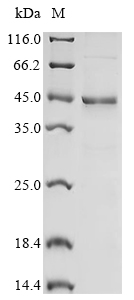Recombinant Human NAD (+) hydrolase SARM1 (SARM1) , partial
CAT:
399-CSB-EP750971HU1-02
Size:
100 µg
Price:
Ask
- Availability: 24/48H Stock Items & 2 to 6 Weeks non Stock Items.
- Dry Ice Shipment: No




Recombinant Human NAD (+) hydrolase SARM1 (SARM1) , partial
- CAS Number: 9000-83-3
- Gene Name: SARM1
- UniProt: Q6SZW1
- Expression Region: 409-702aa
- Organism: Homo sapiens
- Target Sequence: VPSWKEAEVQTWLQQIGFSKYCESFREQQVDGDLLLRLTEEELQTDLGMKSGITRKRFFRELTELKTFANYSTCDRSNLADWLGSLDPRFRQYTYGLVSCGLDRSLLHRVSEQQLLEDCGIHLGVHRARILTAAREMLHSPLPCTGGKPSGDTPDVFISYRRNSGSQLASLLKVHLQLHGFSVFIDVEKLEAGKFEDKLIQSVMGARNFVLVLSPGALDKCMQDHDCKDWVHKEIVTALSCGKNIVPIIDGFEWPEPQVLPEDMQAVLTFNGIKWSHEYQEATIEKIIRFLQGR
- Tag: N-terminal 6xHis-KSI-tagged
- Source: E.coli
- Field of Research: Cell Biology
- Assay Type: In Stock Protein
- Relevance: NAD (+) hydrolase, which plays a key role in axonal degeneration following injury by regulating NAD (+) metabolism . Acts as a negative regulator of MYD88- and TRIF-dependent toll-like receptor signaling pathway by promoting Wallerian degeneration, an injury-induced form of programmed subcellular death which involves degeneration of an axon distal to the injury site . Wallerian degeneration is triggered by NAD (+) depletion: in response to injury, SARM1 is activated and catalyzes cleavage of NAD (+) into ADP-D-ribose (ADPR), cyclic ADPR (cADPR) and nicotinamide; NAD (+) cleavage promoting cytoskeletal degradation and axon destruction . Also able to hydrolyze NADP (+), but not other NAD (+)-related molecules . Can activate neuronal cell death in response to stress . Regulates dendritic arborization through the MAPK4-JNK pathway. Involved in innate immune response: inhibits both TICAM1/TRIF- and MYD88-dependent activation of JUP-1, TRIF-dependent activation of NF-kappa-B and IRF3, and the phosphorylation of MAPK14/p38 .
- Purity: Greater than 85% as determined by SDS-PAGE.
- Activity: Not Test
- Length: Partial
- Form: Liquid or Lyophilized powder
- Buffer: If the delivery form is liquid, the default storage buffer is Tris/PBS-based buffer, 5%-50% glycerol. If the delivery form is lyophilized powder, the buffer before lyophilization is Tris/PBS-based buffer, 6% Trehalose, pH 8.0.
- Reconstitution: We recommend that this vial be briefly centrifuged prior to opening to bring the contents to the bottom. Please reconstitute protein in deionized sterile water to a concentration of 0.1-1.0 mg/mL.We recommend to add 5-50% of glycerol (final concentration) and aliquot for long-term storage at -20℃/-80℃. Our default final concentration of glycerol is 50%. Customers could use it as reference.
- Molecular Weight: 48.8 kDa
- References & Citations: "SARM inhibits both TRIF- and MyD88-mediated AP-1 activation." Peng J., Yuan Q., Lin B., Panneerselvam P., Wang X., Luan X.L., Lim S.K., Leung B.P., Ho B., Ding J.L. Eur. J. Immunol. 40:1738-1747 (2010)
- Storage Conditions: The shelf life is related to many factors, storage state, buffer ingredients, storage temperature and the stability of the protein itself. Generally, the shelf life of liquid form is 6 months at -20℃/-80℃. The shelf life of lyophilized form is 12 months at -20℃/-80℃.
